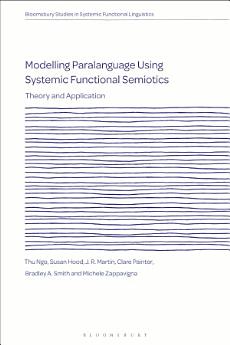Modelling Paralanguage Using Systemic Functional Semiotics: Theory and Application
dic 2021 · Bloomsbury Publishing
eBook
280
Páginas
reportLas valoraciones y las reseñas no se verifican. Más información
Información sobre este eBook
Winner of the ASFLA (Australian Systemic Functional Linguistics Association) M. A. K. Halliday Prize 2023
This book is the first comprehensive account of 'body language' as 'paralanguage' informed by Systemic Functional Semiotics (SFS). It brings together the collaborative work of internationally renowned academics and emerging scholars to offer a fresh linguistic perspective on gesture, body orientation, body movement, facial expression and voice quality resources that support all spoken language.
The authors create a framework for distinguishing non-semiotic behaviour from paralanguage, and provide a comprehensive modelling of paralanguage in each of the three metafunctions of meaning (ideational, interpersonal and textual). Illustrations of the application of this new model for multimodal discourse analysis draw on a range of contexts, from social media vlogs, to animated children's narratives, to face-to-face teaching. Modelling Paralanguage Using Systemic Functional Semiotics offers an innovative way for dealing with culture-specific and context specific paralanguage.
This book is the first comprehensive account of 'body language' as 'paralanguage' informed by Systemic Functional Semiotics (SFS). It brings together the collaborative work of internationally renowned academics and emerging scholars to offer a fresh linguistic perspective on gesture, body orientation, body movement, facial expression and voice quality resources that support all spoken language.
The authors create a framework for distinguishing non-semiotic behaviour from paralanguage, and provide a comprehensive modelling of paralanguage in each of the three metafunctions of meaning (ideational, interpersonal and textual). Illustrations of the application of this new model for multimodal discourse analysis draw on a range of contexts, from social media vlogs, to animated children's narratives, to face-to-face teaching. Modelling Paralanguage Using Systemic Functional Semiotics offers an innovative way for dealing with culture-specific and context specific paralanguage.
Acerca del autor
Thu Ngo is Lecturer in Language and Literacy in the School of Education at Australian Catholic University, Australia.
Susan Hood is Honorary Associate Professor in the Department of Linguistics, University of Sydney, Australia.
J. R. Martin is Professor of Linguistics at the University of Sydney, Australia.
Clare Painter is Honorary Associate in the Department of Linguistics, University of Sydney, Australia.
Bradley A. Smith is Honorary Associate in the Department of Linguistics, University of Sydney, Australia.
Michele Zappavigna is Associate Professor in the School of the Arts & Media at the University of Sydney, Australia.
Susan Hood is Honorary Associate Professor in the Department of Linguistics, University of Sydney, Australia.
J. R. Martin is Professor of Linguistics at the University of Sydney, Australia.
Clare Painter is Honorary Associate in the Department of Linguistics, University of Sydney, Australia.
Bradley A. Smith is Honorary Associate in the Department of Linguistics, University of Sydney, Australia.
Michele Zappavigna is Associate Professor in the School of the Arts & Media at the University of Sydney, Australia.
Valorar este eBook
Danos tu opinión.
Información sobre cómo leer
Smartphones y tablets
Instala la aplicación Google Play Libros para Android y iPad/iPhone. Se sincroniza automáticamente con tu cuenta y te permite leer contenido online o sin conexión estés donde estés.
Ordenadores portátiles y de escritorio
Puedes usar el navegador web del ordenador para escuchar audiolibros que hayas comprado en Google Play.
eReaders y otros dispositivos
Para leer en dispositivos de tinta electrónica, como los lectores de libros electrónicos de Kobo, es necesario descargar un archivo y transferirlo al dispositivo. Sigue las instrucciones detalladas del Centro de Ayuda para transferir archivos a lectores de libros electrónicos compatibles.





